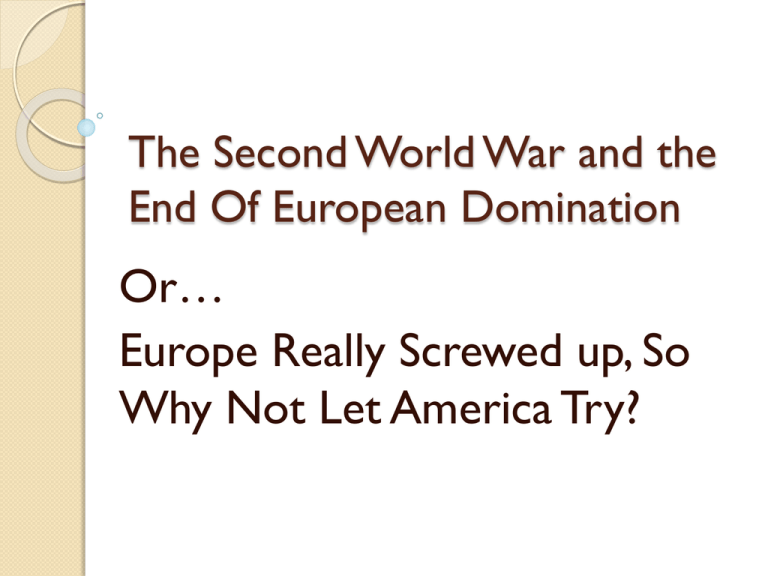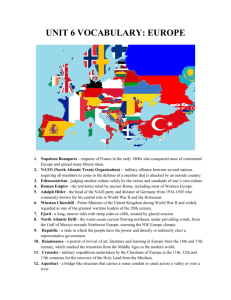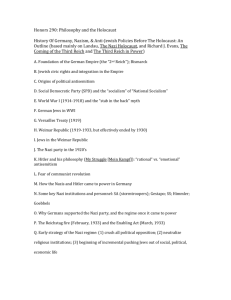The Second World War and the End Of European Domination
advertisement

The Second World War and the End Of European Domination Or… Europe Really Screwed up, So Why Not Let America Try? Writing into the Day Why do you think the State of Israel was created? Should the State of Israel have been created? Justify your answer. CHAPTER SUMMARY In contrast to the disorganized beginning of World War I, World War II was provoked by deliberate aggressions of Germany, Japan, and Italy. The failures of the Western policy of appeasement encouraged the Axis Powers’ militaristic expansions. The most deadly conflict in history, World War II, resulted in the rise of the United States and the Soviet Union to world preeminence and competition. Western European hegemony came to an end as independence movements in Africa and Asia succeeded in the decades after the war. Key Terms National Socialist (Nazi) Party: Fascist party of Adolf Hitler in Germany. Blitzkrieg: Fast-moving “lightning war” used by Germany to invade its neighbors in World War II. Winston Churchill: Inspirational leader of Britain in World War II. Battle of Britain: Failed German attempt to bomb Britain into submission in World War II. British grit and technology outlasted Hitler. Holocaust: Name given to the genocide of as many as 12 million people by the Nazi regime; 6 million of these were Jews. The Holocaust was notable for its especially brutal, systematic, and premeditated nature. Battle of the Bulge: Last German offensive on the Western Front in World War II. Its failure hastened German defeat. Pearl Harbor: American outpost in Hawaii that was surprise-attacked by the Japanese; triggered the official U.S. involvement in World War II. Key Terms (continued) Battle of the Coral Sea; Midway Island: Turning points of the Pacific theater in World War II. Japanese advances halted after these battles. United Nations: Successor to the League of Nations, this U.S.-backed international organization had more success in all ways than its predecessor. Tehran Conference: Allied war conference where later Cold War tensions first appeared. Yalta Conference: Most significant of the Allied war conferences; divided post-Nazi Europe and set the stage for Soviet-U.S. tensions for the next 45 years. Potsdam Conference: Final Allied war conference in which the Soviet Union pledged to enter the war against Japan. Total War: Concept in warfare in which all the industrial and civilian might of a nation is linked to strategy and tactics on the battlefield. Atlantic Charter: Alliance between the U.S. and Britain in 1941 that pledged mutual defense and the “right of all people to choose the form of government under which they live.” Key Terms (continued) Quit India Movement: Mass civil disobedience campaigns in India against British rule in 1942. Muslim League: Supported the partitioning of India into secular and Muslim states. The result of this political group’s goal was the creation of Pakistan. Muhammad Ali Jinnah: Leader of the Muslim League and first president of Pakistan. Convention Peoples Party (CPP): Founded by Nkrumah in Ghana to support independence from Britain. He organized mass rallies, strikes, and boycotts. Jomo Kenyatta; Kenya African Union: Leader of independence movement in Kenya; supported nonviolent protest. Land Freedom Army: More radical independence group in Kenya that conducted terrorism and guerilla warfare against the colonizers. Secret Army Organization: Reactionary settler military group that directed its aim at Arabs and Berbers in Algeria. Key Terms (continued) Afrikaner National Party: Majority party in the all-white South African legislature, it won complete independence from Britain and maintained minority domination over the black majority. Apartheid: Rigid system of racial segregation in South Africa; established after 1948 and lasting until majority rule began there in the 1990s. Haganah: Zionist military force that spearheaded Jewish resistance to the British presence in Palestine. Vichy: French collaborationist government established in 1940 in southern France following defeat of French armies by the Germans. Holocaust: Term for Hitler’s attempted genocide of European Jews during World War II; resulted in the deaths of 6 million Jews. Kenya African Union (KAU): Leading nationalist part in Kenya; adopted nonviolent approach to ending British control in the 1950s. National Liberation Front (FLN): Radical nationalist movement in Algeria; launched sustained guerilla war against France in the 1950s; success led to independence of Algeria in 1958. Keep it in Order The Theaters of WWII Old and New Causes of a Second World War. Grievances from World War I’s aftermath and economic havoc resulted in militarist responses from Japan, Germany and Italy. Japan attacked Manchuria in 1931, and politicians in the West responded with a collective shrug. In contrast to Japan’s gradual shift towards the military, Germany’s was abrupt. Adolf Hitler promised to restore Germany’s onceimpressive economic and military place in Europe and to eliminate the Communist threat within its borders. In alliance with Italy, Germany assisted the fascist takeover of Spain. Unchecked Aggression and the Coming of War in Europe and the Pacific. By the late 1930s a number of patterns were clearly established in the interaction between the new totalitarian states of Germany, Italy, and Japan and Western democracies. The lesson eventually learned by the West was that unchecked aggression led to yet more aggression. This lesson was taught most clearly at Munich. As China and Japan bitterly struggled throughout the 1930s for control of east Asia, the West to a great extent watched from the sidelines. Nazi Blitzkrieg, Stalemate, and the Long Retreat. By mid-1940 the Germans controlled most of the continent of Europe and much of the Mediterranean. After western Europe fell to Germany, the Nazis invaded the Soviet Union. Battles between Nazi and Soviet troops were among the largest ever and led to the weakening of the German war effort. North Africa was also the site of many battles, as was Italy. With tremendously effective help from the United States, the Allies slowly pushed the Germans back within their borders after six years of fighting. From Persecution to Genocide: Hitler’s War Against the Jews Jews, Polish intellectuals, and Communists were rounded up and killed during German offensives into eastern Europe. The destruction of the Jewish people became the official policy of the Nazi reich. Concentration camps set up in the 1930s became the death camps of perhaps as many as 12 million people in the 1940s, 6 million of those of the Jewish faith. Anglo-American Offensives, Encirclement, and the End of the 12-Year Reich. American and British forces countered Nazi gains first in the Atlantic and in north Africa. Their attack into Italy eventually forced the toppling of Mussolini. In 1944, the Allies invaded and pushed the Germans out of northern France. The last German offensive in the West, near the French/Benelux borders, resulted in their eventual defeat in the spring of 1945. At the same time, the Soviet army poured in from the East after years of bitter, brutal fighting. Germany was spent. The Rise and Fall of the Japanese Empire in the Pacific War. After Pearl Harbor, Japan quickly captured many European holdings all over the Pacific. With support from Great Britain, Australia, and New Zealand, the United States exploited Japan’s strategic and material weaknesses with clever strategies and brute force. With the first use of atomic weapons by the U.S., the war against Japan came to a sudden end. War’s End and the Emergence of the Superpower Standoff. The end of World War II led to a decades-long confrontation between the U.S. and the U.S.S.R. and their allies. Both were members of the United Nations, formed during the war as the official name of the anti-Axis Allies. After World War II, the UN did much to aid refugees and to promote health care worldwide. From Hot War to Cold War. The Cold War, lasting from the late 1940s to the late 1980s, rose from disagreements between the U.S.S.R. and its World War II allies over postwar territorial settlements. Korea was divided into Soviet and U.S. zones and Germany’s holdings were similarly divvied up in Europe. The stage was set for two of the great movements of the latter half of the 20th century: first, decolonization and second, the Cold War. Nationalism and Decolonization. The end of World War II marked the beginning of an age of nationalist movements in the European colonies in Africa and Asia. The Winning of Independence in South and Southeast Asia. The outbreak of World War II ended the uneasy alliance between the Indian National Congress and Britain. Massive civil disobedience campaigns and the arrest of Gandhi and Nehru strained relations between the two. The Muslim League, supporters of the partition of India into Hindu and Muslim sectors, rallied to the British cause. In 1947, the jewel in the British crown was divided into India and Pakistan; later Sri Lanka and Burma (Myanmar) also received independence. The retreat of the once powerful British from Asia prompted similar responses from the Dutch and French, most notably in Indonesia and Vietnam. The Liberation of Nonsettler Africa. Independence movements in nonsettler Africa were initiated by Westerneducated individuals, like Nkrumah in Ghana. By the mid-1960s the British, French, Portugese, and Belgian nonsettler colonies in Africa were independent. Repression and Guerilla War: The Struggle for the Settler Colonies. The pattern of relatively peaceful withdrawal established in nonsettler colonies in Africa was not the norm in settler colonies like Algeria, Kenya, and southern Rhodesia. Instead, years of bloody fighting brought independence. The Persistence of White Supremacy in South Africa. Only in South Africa did the white minority manage to maintain power after 1980. Apartheid was established after 1948, upheld by thousands of laws and a brutal police force. Conflicting Nationalisms: Arabs, Israelis, and the Palestinian Question. Though several Middle Eastern states gained independence after World War I, it was not until after World War II that it became complete. The fate of the Palestinians, however, was a different matter. In Palestine, conflicting strains of nationalism collided. The British managed to suppress a major Muslim revolt in Palestine in the late 1930s. At the same time, they limited Jewish immigration into the region. After World War II and the Holocaust, world sentiment was mostly with Jews desiring a homeland, and the major parties claiming Palestine found themselves at a stalemate, which erupted into warfare. The Zionists were better armed and led and expanded their Unsanctioned territory to include much of that reserved for the Palestinians. The legacy of colonialism proved even more of a liability here than in much of Asia and Africa. The Partition of Israel Seminar Why do you think the State of Israel was created? Should the State of Israel have been created? Refer to the document: http://www.fordham.edu/halsall/mod/1957ei senhowerdoctrine.html






